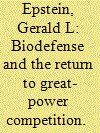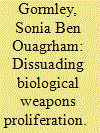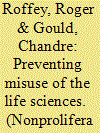|
|
|
Sort Order |
|
|
|
Items / Page
|
|
|
|
|
|
|
| Srl | Item |
| 1 |
ID:
182961


|
|
|
|
|
| Summary/Abstract |
The 2017 US National Security Strategy asserts that, “after being dismissed as a phenomenon of an earlier century, great power competition returned,” pointing to actions that Russia and China have taken to reassert their influence and attempt to change the international order. Such a shift has implications for biodefense. It suggests an increased likelihood of the development and potential use of biological weapons by states, which had been downplayed by those who have been more concerned about non-state biological-weapons programs. State program access to expertise, facilities, and resources implies a greater level of technological sophistication than would typically be credited to non-state actors, influencing the requirements for national biodefense programs to detect, characterize, respond, to, and attribute a biological attack. States also could have missions for biological weapons that differ from those intended by terrorists.
|
|
|
|
|
|
|
|
|
|
|
|
|
|
|
|
| 2 |
ID:
124994


|
|
|
|
|
| Publication |
2013.
|
| Summary/Abstract |
The terrorist and anthrax attacks of 2001 spurred many countries to raise defences against a possible biological weapon attack, and potentially dissuade state and non-state actors from developing these weapons. Yet these programmes' dissuasive value - creating strong barriers to entry - has never been analysed. This article argues that current biodefence efforts are counterproductive and more persuasive than dissuasive, because they rest on a biological threat narrative that emphasizes the benefits of bioweapons rather than their problematic development and use, and they fail to impose a high cost of entry in the bioweapons field. The dominant biological weapons narrative perpetuates several misconceptions, including that there are no barriers to biological weapons development, that expertise is easily acquired from scientific documents, and that new technologies are black boxes with de-skilling effects. The net result is popularization of a cost/benefit analysis in favour of bioweapons development. To remedy the situation, I suggest correcting these misconceptions by reshaping the biological threat narrative, and recommend policies to achieve a greater dissuasive impact, stressing the role of the Biological Weapons Convention, preventing access to tacit biological weapons skills, and criminalizing bioweapons proliferation by making the development and use of biological weapons a crime against humanity.
|
|
|
|
|
|
|
|
|
|
|
|
|
|
|
|
| 3 |
ID:
107573


|
|
|
|
|
| Publication |
2011.
|
| Summary/Abstract |
The scope of the Biological Weapons Convention (BWC) is sufficiently broad to deal with new threats emerging from developments in the life sciences; however, more thought still needs to be given to updating and improving measures to encourage biodefense-related information sharing and transparency between states. Biodefense is and has been at the core of the BWC, but the threat of bioterrorism should not distract BWC state parties or cause them to disregard the risk that illicit state-run bioweapons programs will utilize new advances in the life sciences. More states are pursuing biodefense programs-and spending more on such programs. The BWC community must address the issue of how states and civil society observers can determine the point at which a biodefense program, or parts of it, could be secretly transformed into an offensive bioweapons program. The authors propose several measures for increasing the transparency of biodefense programs, including: national oversight, confidence-building measures, mandatory codes of practice, confidence-building visits, and an international mechanism to encourage and protect whistleblowers. The authors conclude that unless accountability and transparency in biodefense programs can be attained within the next five years, the BWC will lose its relevance.
|
|
|
|
|
|
|
|
|
|
|
|
|
|
|
|
| 4 |
ID:
108433


|
|
|
|
|
| Publication |
2011.
|
| Summary/Abstract |
In recent years, there has been an increase in the perceived threat of biological agents being used against civilian populations. This has prompted an urgent need for the development and procurement of medical countermeasures (MCMs) against highly pathogenic viruses that can prevent morbidity and mortality from infections caused by these agents. To date, antiviral drug development has been largely focused on clinically prevalent chronic infections due to their commercial viability. This has left a huge gap in the drug development path for acute infections of biodefense importance. In this review, we discuss the antiviral research and development initiatives focusing specifically on poxviruses, filoviruses, and equine encephalitis viruses (EEV). We discuss the benefits and technical challenges in the current development strategies and the hurdles in the licensure path for MCMs against these highly pathogenic viruses under the FDA Animal Rule, and we provide recommendations for the path forward.
|
|
|
|
|
|
|
|
|
|
|
|
|
|
|
|
|
|
|
|
|